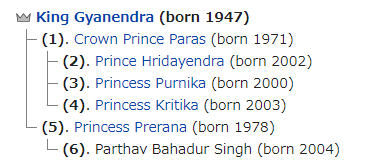note:
As of August 2020.
Prior to abolition of the monarchy in 2008, the line of succession to the throne of Nepal was expected to be determined in future by absolute primogeniture. In 2006 the Nepalese government proposed elimination of the Salic restriction to the law of primogeniture, which allocated the throne to members of the reigning dynasty by seniority in descent to the exclusion of women.[1] The House of Representatives subsequently approved the bill. As per the amended law, a Special Committee under the Prime Minister would propose specific modifications for accession to the throne, which would have to be approved by the parliament.[2][3][4][5][6][7]
The line of succession immediately before the abolition of the monarchy was as follows:
- King Gyanendra (born 1947)
- (1). Crown Prince Paras (born 1971)
- (2). Prince Hridayendra (born 2002)
- (3). Princess Purnika (born 2000)
- (4). Princess Kritika (born 2003)
- (5). Princess Prerana (born 1978)
- (6). Parthav Bahadur Singh (born 2004)
- (1). Crown Prince Paras (born 1971)

End of monarchy
By an overwhelming majority, on Friday, 28 December 2007, the makeshift Nepalese Parliament voted to abolish the monarchy in favor of a republic. The abolition was officially approved on 28 May 2008, by a vote among elected members of the Constituent Assembly.[8] The Rastriya Prajatantra Party Nepal is a party that supports the restoration of the Hindu kingdom in Nepal under the Shah dynasty.[9]

